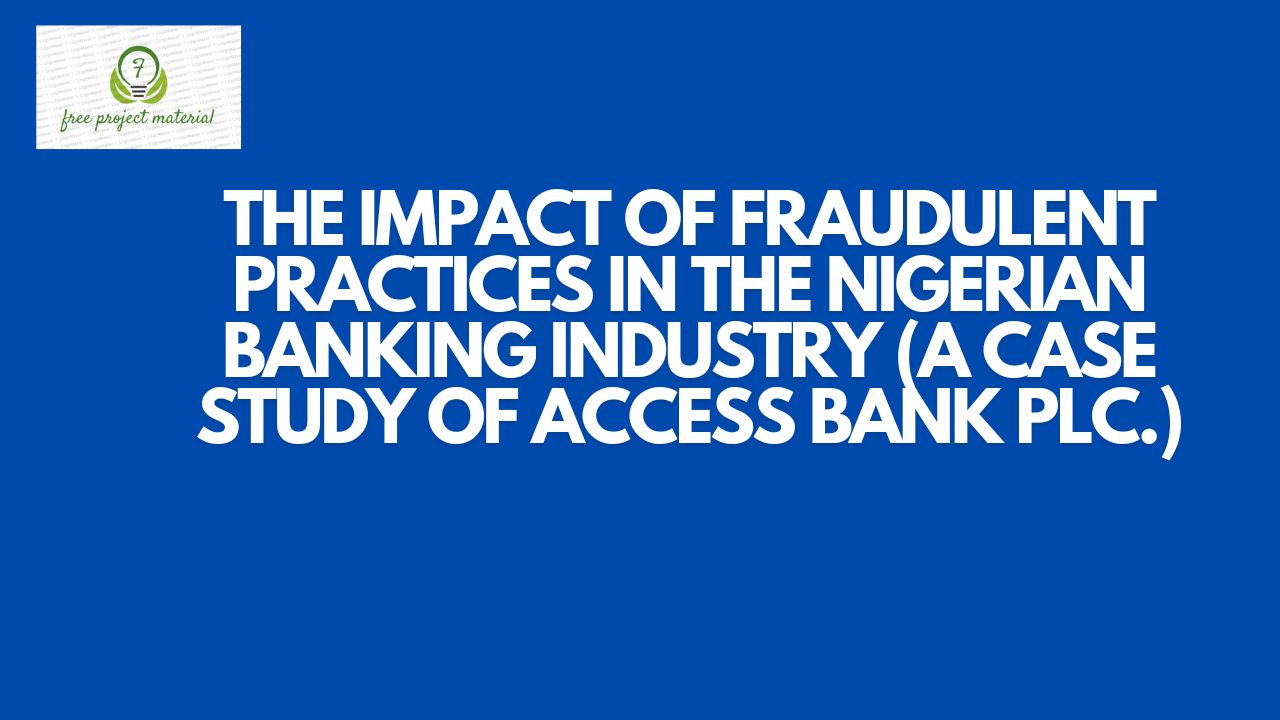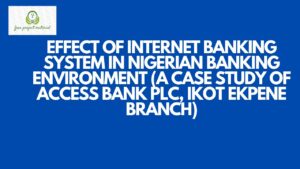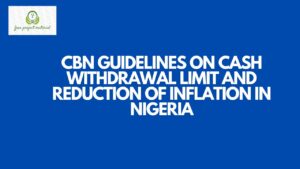ABSTRACT
This study was aimed at examining the impact of fraudulent practices on the Nigerian banking industry. The study adopted survey research design while Taro Yamane’s formula for sampling was used to select (36) respondents as sample size for the study. Instrument of data collections was self-developed questionnaire. Data were analyzed using simple percentages and frequency tables. The study revealed that; Impacts of fraudulent practices in banking industry are: it leads to loss of confidence in business, leads to insolvency or winding up of business and attendant loss of staff. Theft and embezzlement, forgeries and lending to ghost borrowers are the fraudulent practices common in Nigerian banking industry. Fraud is perpetrated in Nigerian banks by halting of CCTV camera functionality, bypassing of security protocols and initiating proceed sharing strategy with alliance. Ways to detect fraudulent practices in Nigerian banks are regular audit by external auditors, special intelligence surveillance and sophisticated division of labour to staff in a manner to enhance tracing of faults and fund misappropriation. The means to minimizing fraud in Nigerian banks are introduction of artificial intelligence, generation of consortium data, and high tech standardization. The study recommends that; banks need to strengthen their internal control systems to be able to detect and prevent fraud and fraudulent activities and to protect its assets. Also, the regulatory and supervisory bodies of banks in Nigeria need to improve their supervision using all tools at their disposal to appropriately check and curtail the incidence of fraud and fraudulent practices in the banking industry in Nigeria.
LIST OF TABLES
Pages
Table 4.2.1: Responses to Research Question One – – 43
Table 4.2.2: Responses to Research Question Two – – 44
Table 4.2.3: Responses to Research Question Three – – 45
Table 4.2.4: Responses to Research Question Four – – 46
Table 4.2.5: Responses to Research Question Five – – 47
TABLE OF CONTENTS
Pages
Title Page – – – – – – – – i
Declaration – – – – – – – – – ii
Certification – – – – – – – – – iii
Dedication – – – – – – – – – iv
Acknowledgements – – – – – – – – v
Abstract – – – – – – – – – vi
List of Tables – – – – – – – – – vii
Table of Contents – – – – – – – – viii
CHAPTER ONE
INTRODUCTION
1.1 Background of the Study – – – – – – 1
1.2 Statement of the Problem – – – – – – 3
1.3 Objectives of the Study – – – – – – 5
1.4 Research Questions – – – – – – – 5
1.5 Significance of the Study – – – – – – 6
1.6 Scope and Limitations of the Study – – – – 7
1.7 Organization of the Study – – – – – – 8
1.8 Definition of Terms – – – – – – – 8
CHAPTER TWO
REVIEW OF RELATED LITERATURE
2.1 Conceptual Framework – – – – – – 10
2.1.1 Concept of Fraud and Fraudulent Practices – – – 10
2.1.2 Nature and Magnitude of Fraud – – – – – 12
2.1.3 Types of Banking Fraud – – – – – – 15
2.1.3.1 Employee theft – – – – – – – 15
2.1.3.2 Management thefts – – – – – – – 16
2.1.3.3 Payroll fraud – – – – – – – – 17
2.1.3.4 Corporate frauds – – – – – – – 18
2.1.3.5 Money Laundering – – – – – – – – 19
2.1.3.6 Credit Cards and Insurance Fraud – – – – – 19
2.1.3.7 Insurance Fraud – – – – – – – 20
2.1.4 Challenges of Fraud Prevention in Banking Industry – – 20
2.1.5 Fraud Prevention Strategies – – – – – – 21
2.2 Theoretical Framework – – – – – – 24
2.3 Empirical Review – – – – – – – 27
2.4 Summary of Related Literature – – – – – 31
2.5 Research Gap – – – – – – – – 33
CHAPTER THREE
RESEARCH METHODOLOGY
3.1 Research Design – – – – – – – 34
3.2 Area of the Study – – – – – – – 34
3.3 Population of the Study – – – – – – 34
3.4 Sample and Sampling Techniques – – – – – 34
3.5 Source and Nature of Data – – – – – 35
3.6 Instrument and Method of Data Collection – – – 35
3.7 Method of Data Analysis – – – – – – 36
3.8 Empirical Specification of model – – – – – 36
3.9 Ethical Issues – – – – – – – 37
CHAPTER FOUR
DATA PRESENTATION, ANALYSIS AND INTERPRETATION
4.1 Presentation of Data – – – – – – 38
4.2 Analysis of Data – – – – – – – 42
4.2.1 Research Question One – – – – – – 42
4.2.2 Research Question Two – – – – – – 44
4.2.3 Research Question Three – – – – – – 45
4.2.4 Research Question Four – – – – – – 46
4.2.5 Research Question Five – – – – – – 47
4.3 Discussion of Findings – – – – – – 48
CHAPTER FIVE
FINDINGS, CONCLUSION AND RECOMMENDATIONS
5.1 Findings – – – – – – – – 51
5.2 Conclusion – – – – – – – – 52
5.3 Recommendations – – – – – – – 52
5.4 Implication of Findings – – – – – – 53
5.5 Contribution of Knowledge – – – – – 54
5.6 Suggestion for further Studies – – – – – 54
References
Appendix
CHAPTER ONE
INTRODUCTION
1.1 BACKGROUND OF THE STUDY
Fraudulent activities are generic in nature and can be clearly classified as global phenomenon which is found in all economies: developed, developing and under-developed. The banking industries in all economies are not left out in the ravaging trend of frauds and fraudulent activities. Admittedly, Owolabi (2010) noted that the problem of fraud in the banking industry is not limited to any economy, nation, continent or environment. Fraud is a universal problem as no nation is exempt from it, although developing countries at their various states and stages suffer the most pain (Okoye & Gbegi, 2013). On the part of its negative implications on victims: institutions and persons, the untold consequences of fraudulent practices, which are measurable by the volume of the present and consequential losses, are both monumental and can hit the root of the victim.
Fraudulent practices affect businesses and deplete resources meant for business transactions and on extreme cases can exterminate institutions irrespective of their assets base and sources of funding. This is more applicable to Deposit Money Banks (DMBs) whose stock in trade is raw cash which is highly susceptible to fraud. Nwankwo (2005) buttress this by opining that the fear now is that the increasing rate of fraud in financial institutions, if not arrested might pose certain threats to the stability and survival of individual financial institutions and the performance of the industry as a whole and that no area of the economy is immune from fraudsters. Depletion of liquidity of money deposit banks through fraudulent practices is unarguably a clear road to liquidation of such banks, if not checked and/or further cash resources injected.
Banks and non-bank financial institutions jointly constitute the financial industry of any economy, however, the banking system comprises the major corner stone of an economy. For any economy to develop and grow, the financial sector must be strong, solid, effective and efficient. The existence of an effective banking industry is a panacea to growing any economy. The pivot of any economic development is the financial sector through its role in intermediating funds from the surplus units to deficit units. This also stimulates investment, economic growth and employment as well as international trade and payment. The significant roles played by financial institutions are responsible for the importance accorded them by every economy of the world. However, over the years, the Nigerian banking industry has witnessed several reforms in search of an efficient and effective financial system.
A prominent feature of bank failure which led to the reforms in the banking sector in Nigeria was fraud. This indicates a fundamental problem with fraud investigation and management in Nigerian banks. There is, therefore, need for a comprehensive fraud management scheme to have a holistic view of all the factors involved in fraud occurrence. The holistic scheme, as Wilhelm (2004) opines, includes fraud deterrence, fraud prevention, fraud detection, fraud mitigation, fraud analysis, fraud policy, fraud investigation and fraud prosecution. These stages must be successfully integrated and balanced to reap the benefits of advancements in fraud detection technologies and to save the economy from continuous loss of money to fraud and fraudulent activities in the banking sector in Nigeria.
Therefore, the aim of this study is to ascertain the impacts of fraudulent practices in the Nigerian Banking Industry using Access Bank Plc as the case study.
1.2 Statement of the Problem
The banking business has become more complex with numerous developments in the field of Information and Communication Technology (ICT) which has changed the nature of bank fraud and fraudulent practices. Berney (2008) observes that customers rely heavily on the web for their banking businesses which leads to an increase in the number of online transactions. Gates and Jacob (2009) and Malphrus (2009) assert that the internet provides fraudsters with more opportunities to attack customers who are not physically present on the web to authenticate transactions. Within a 6 year period, the FBI received 207,051 Suspicious Activity Reports (SARs) for criminal activities related to cheque fraud, cheque kiting, counterfeit cheques, and counterfeit negotiable instruments. These fraudulent activities accounted for 47 percent of the 436,655 SARs filed by U.S. financial institutions and equaled approximately $7 billion in expected losses (U.S. Department of Justice [DOJ], 2002). According to Greene (2009), the true economic costs are about 150 percent of the actual fraud loss.
In Nigeria, in spite of the banking regulations and bank examinations by the Central Bank of Nigeria (CBN), the supervisory role of the Nigeria Deposit Insurance Corporation (NDIC), and The Chartered Institute of Bankers of Nigeria (CIBN), there is still a growing concern about fraud and other unethical practices in the banking industry. Evidence from the NDIC Report (2008) reveals that the report of the examinations and special investigations showed that some banks were still bedevilled with problems of fraud, weak board and management oversight; inaccurate financial reporting; poor book-keeping practices; non-performing insider-related credits; declining asset quality and attendant large provisioning requirements; inadequate debt recovery; non-compliance with banking laws, rules and regulations; and significant exposure to the capital market through share and margin loans. To affirm the NDIC report, Okpara (2009) found that one of the factors that impacted the most on the performance of the banking system in Nigeria was fraudulent practices. This situation should therefore be of immense concern to all: the government, citizens, the banks etc. Thus, this study is undertaken to examine the impact of fraudulent practices in the Nigerian Banking Industry (a case study of Access Bank Plc).
1.3 Objectives of the Study
- To examine the impact of fraudulent practices in the Nigerian banking industry.
- To ascertain the nature and types of fraudulent practices common in the Nigerian Banking Industry
- To examine how fraud is perpetrated in Nigerian banks
- To ascertain how fraud can be detected in Nigerian banks
- To determine means of minimizing the incidence of fraud in Nigerian Banking Industry.
1.4 Research Questions
- What are the impacts of fraudulent practices in the Nigerian Banking Industry?
- What are the nature/types of fraudulent practices common in the Nigerian Banking Industry?
- How are fraud perpetrated in Nigerian Banks?
- What are the ways of detecting fraudulent practices in Nigerian Banks?
- What are the means of minimizing the incidence of fraud in Nigerian Banks?
1.5 Significance of the Study
The significance of this study is that it will be beneficial to investors, shareholders and other stake holders in the banking industry, the government and members of the public as they will be able to know the nature/types, the extent of controlling and preventing of frauds that exist in Nigerian banks.
The significance of this study to banking industry and society at large cannot be over emphasized at least to probe into causes, effects and solutions to the incessant fraud practices in banks.
This study will also serve as a references materials to students and researchers in this field.
This work will also serve as source of information to other financial institution on the increasing prevalence of fraudulent practices which could serve as bases for decision making and fraud management strategies.
1.6 Scope and Limitation of the Study
This study focused on the impact of fraudulent practices in the Nigerian Banking Industry (using Access Bank Plc as a case study)
During the conduct of this research work, some factors posed as constraints tended to undermine the efforts of the researcher to carry out the research study to such a depth and in such a manner that it ought to have been carried out judging from the relevance of the topic. Such factors include:
- Reluctant attitudes of respondents to give attention and provide answers to the questionnaire forms.
- Time Constraint: Time was also another factor that acted as hindrance in carrying out this research study. This was as a result of the fact that other things were still being attended to in the course of carrying out this research work.
- Financial Constraint: money also acted as a problem in the conduct of this research work. Travelling expenses were incurred in getting the materials for the research work. Also incurred were expenses for the typing and distribution, and a lot of other expenses.
1.7 Organization of the Study
The study is organized into five chapters; chapter one is the introduction which includes: background of the study, research questions, scope of the study, organization of the study and definition of terms.
Chapter two is for the reviews of related literature on the subject matter that is the contribution of scholars and authors on the subject matter.
Chapter three describes the researcher design and methodology, population of the study sample and sampling techniques, instrumentation, method/plan of data analysis and problem of data collection.
Chapter four is concerned with data presentation, analysis and interpretation.
Chapter five gives the summary of findings, conclusion and recommendation.
1.8 Definition of Terms
Fraud: Deceit or trickery deliberately practiced in order to gain some advantages, dishonesty over other perpetrators.
Fraudulent practices: Fraudulent Practice means any action or omission, including misrepresentation, that knowingly or recklessly misleads, or attempts to mislead, a party to obtain a financial benefit or to avoid an obligation.
Internal Control: This refers to the whole system of control, financial and otherwise, established by the management in order to carry on the business of the enterprise in an orderly manner, safeguard its asset and secure as far as possible the accuracy and reliability of its records.
Financial Services Sectors: This involves all financial institutions such as banks, insurance company etc.
Bank: Is an establishment saddled with keeping money and valuables safely, the money being paid out of the customer order
Fraud Management: It is the prevention, detection and control of fraud.
Accountability: Is the rendering of stewardship performance by officials of government to the public.
Probity: The behaviour of being honest in the performance of your job or any other obligation.
Institutional Factors: Are the factors that can be traced to internal environment of the organization
External/Environmental Factors: Environmental factors are those factors that can be traced to the banks’ immediate and remote environment.



